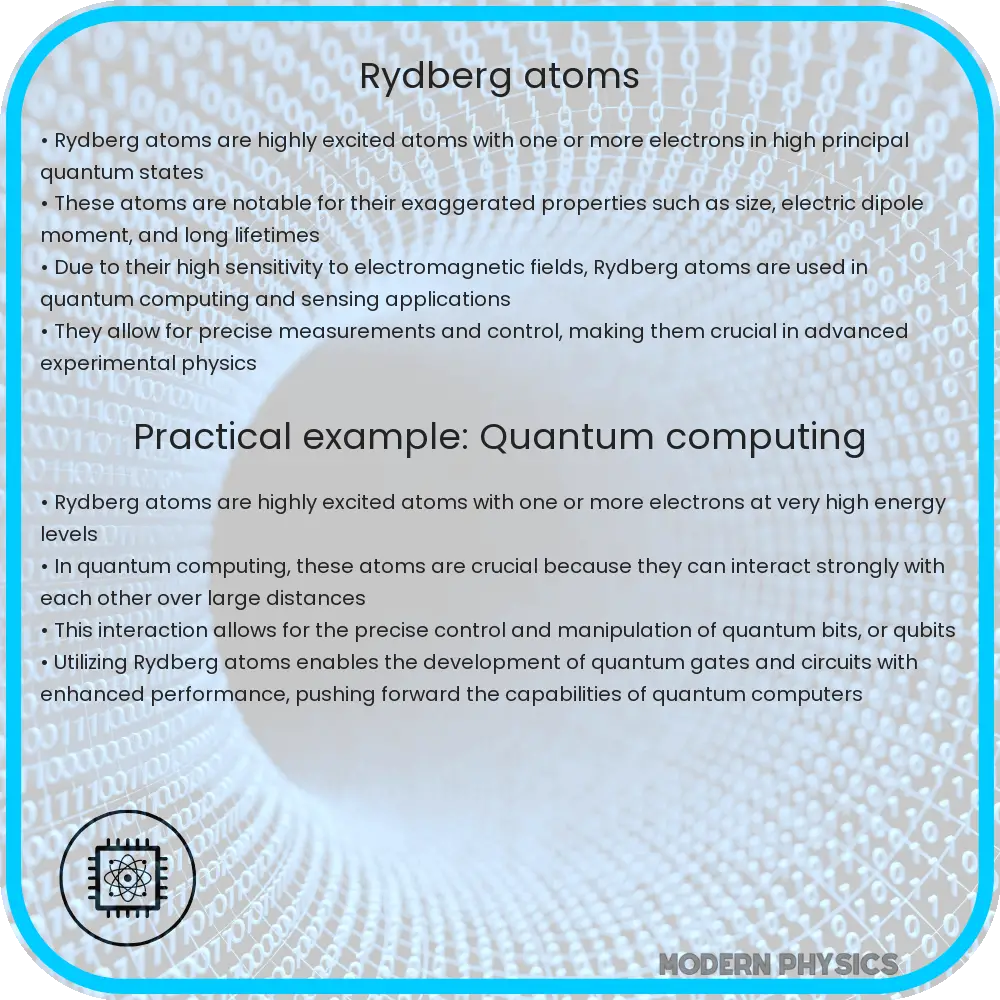Learn about Rydberg atoms, highly excited atomic states with unique properties useful in quantum computing and precision measurements.

Introduction to Rydberg Atoms
Rydberg atoms are a fascinating and specialized state of atoms characterized by having one or more electrons in highly excited states. These atoms are named after the Swedish physicist Johannes Rydberg. Due to their high principal quantum numbers (n), typically n>30, Rydberg atoms exhibit unique properties that differentiate them from regular atoms in lower energy states.
Properties of Rydberg Atoms
The primary characteristic of a Rydberg atom is its large size. As the principal quantum number increases, the average distance of the outermost electron from the nucleus becomes much larger compared to normal atoms. This can lead to atomic radii thousands of times larger than that of ground-state atoms. Additionally, Rydberg atoms are highly polarizable and display magnetic dipole moments significantly larger than those of ordinary atoms.
Another important property of Rydberg atoms is their exaggerated response to electric and magnetic fields. Their large orbital can easily deform in the presence of external fields, which is described by their high electric polarizability. This makes them useful tools for exploring classical and quantum mechanical interactions at atomic and subatomic scales.
Uses of Rydberg Atoms
Rydberg atoms have several practical applications across various fields of physics and technology. One of the most promising applications is in quantum computing. Due to their high sensitivity to electric fields and long-range interactions between each other, Rydberg atoms can be used as qubits, the basic units of quantum information. They are particularly suited for implementing quantum gates and building blocks of quantum circuits.
In addition, Rydberg atoms play a key role in advanced atomic research, such as the testing of fundamental theories of physics, including quantum electrodynamics and cavity quantum electrodynamics. Their sensitivity makes them perfect candidates for precision measurements and sensor technologies. Examples include electric field sensing and single-photon detection.
Experiments with Rydberg Atoms
Experiments with Rydberg atoms often revolve around their interactions within electric and magnetic fields. A classic experimental setup involves using laser excitation to elevate the outer electron to a high-energy state. This is achieved through a process known as laser cooling and trapping, which stabilizes the atoms long enough to study their properties in detail.
Another significant area of experimentation involves utilizing Rydberg atoms in confined geometries such as optical or magnetic traps. Here, physicists can study phenomena like quantum entanglement and collective atomic behavior in a controlled environment. These experiments play a crucial role in advancing our understanding of quantum mechanics and developing new technologies based on quantum principles.
Challenges in Working with Rydberg Atoms
Despite their valuable applications, working with Rydberg atoms presents certain challenges. One of the primary difficulties is their sensitivity to external perturbations. This sensitivity, while beneficial for precision measurements, also makes them susceptible to environmental noise, which can lead to decoherence – a significant problem in quantum computing.
Additionally, producing and maintaining Rydberg atoms in the required excited state demands precise control over experimental conditions, such as temperature and electromagnetic fields. This requires sophisticated equipment and techniques, making experiments with Rydberg atoms complex and costly.
Future Prospects
The study of Rydberg atoms continues to be a dynamic field of research with the potential to revolutionize our understanding of quantum physics and contribute to the development of new technologies. Future research will likely focus on improving the stability and coherence time of Rydberg atoms to make them more practical for technological applications such as quantum computing and sensing.
Advancements in laser technology and electromagnetic field manipulation may also lead to more efficient methods of creating and controlling Rydberg atoms, broadening their application and making the technology more accessible to researchers and industries alike.
Conclusion
Rydberg atoms, with their unique properties and versatile applications, represent a fascinating frontier in the field of atomic physics. From enabling advanced research in quantum mechanics to holding promise for breakthroughs in quantum computing and sensors, Rydberg atoms offer a glimpse into the profound complexities and potential of the quantum world.
As technology advances and our understanding of these atoms deepens, Rydberg atoms could play an essential role in the practical realization of quantum technologies that might one day transform computing, telecommunications, and beyond. While challenges remain, the relentless pursuit of knowledge and technical innovation continues to push the boundaries of what is possible with Rydberg atoms.
